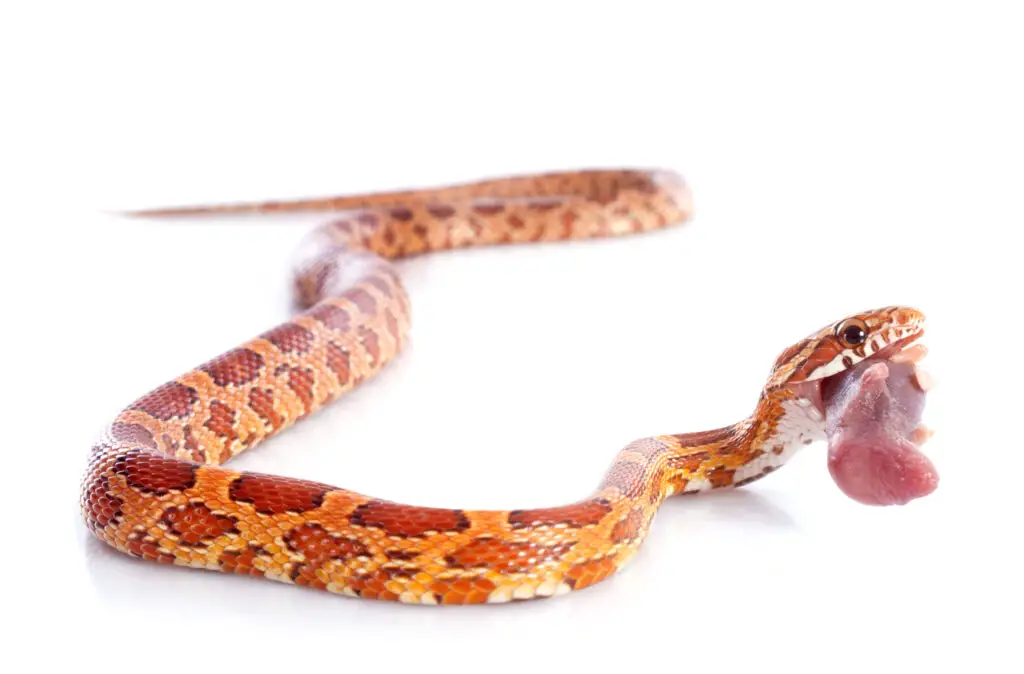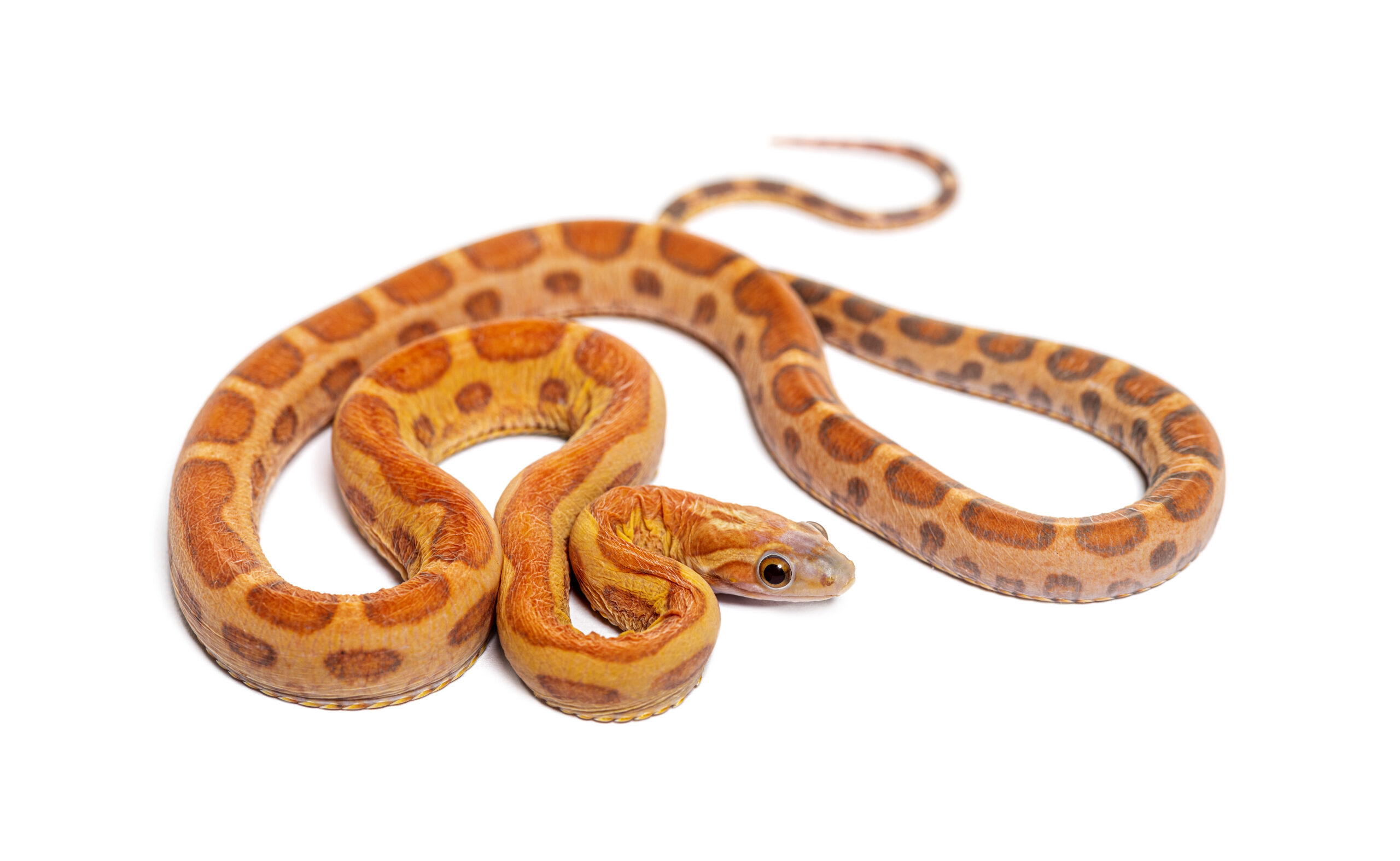Introduction To Corn Snakes And Their Growth
Corn snakes are fascinating creatures that have captured the interest of reptile enthusiasts and casual observers alike. But how big do corn snakes get, and what factors contribute to their growth? In this comprehensive guide, we’ll explore their size and growth rates, the differences between males and females, as well as care tips to ensure healthy development.
From hatchlings to fully grown adults, join us on a fascinating journey into the world of these remarkable serpents.
Key Takeaways
- Corn snakes can grow up to 4 – 5.5 feet in length with females generally being longer than males.
- Factors such as genetics, diet, temperature, and size of enclosure all play a crucial role in the growth rate of corn snakes.
- To promote healthy growth, it’s necessary to provide proper nutrition with appropriately sized prey and ensure adequate exercise and mental stimulation opportunities.
- Understanding the differences between male and female corn snakes’ sizes is essential for owners to anticipate future growth spurts and provide appropriate care.
Average Size And Growth Rate Of Corn Snakes
Corn snakes can grow relatively quickly, with hatchlings measuring 8-12 inches in length and adult snakes growing to 4-5.5 feet long on average, reaching their full size in as little as two years with proper care.
Hatchling Size And Weight
Upon hatching, corn snakes are quite small and delicate creatures. Their size typically ranges from 8 to 12 inches in length, with a weight of approximately 6 to 10 grams.
Comparatively, this is about the same length as a standard sheet of paper or the width of your hand and only slightly heavier than two U.S. pennies.
In their first few weeks of life, hatchling corn snakes require extra care due to their small size and vulnerability. It’s essential for new owners to provide appropriate meals such as pinkie mice – newborn mice that offer an appropriate portion for the hatchlings’ limited capacity while still providing necessary nutrients for healthy growth.
Factors Affecting Growth
Corn snakes exhibit varying growth rates due to a multitude of factors. These factors play a crucial role in determining the overall size and health of the snake. Below is a list of factors that significantly impact corn snake growth:
- Genetics: Inherited traits from parent snakes can influences size and growth rate.
- Diet: A balanced and nutritious diet promotes healthy development. while an inadequate or improper diet may lead to stunted growth.
- Feeding Frequency: Overfeeding or underfeeding can affect a corn snake’s overall size and weight.
- Temperature: Optimal temperature levels within the enclosure help regulate metabolism. which in turn affects growth.
- Tank Size: A spacious and adequately sized tank allows for proper movement, exercise, and growth.
- Health Conditions: Parasites, illnesses, and injuries can slow down or hinder a corn snake’s growth rate.
- Sex: Male and female corn snakes exhibit slight differences in their size and weight.
- Stress Levels: High stress levels can negatively affect a corn snake’s appetite and subsequently its growth progress.
Adult Size And Weight
Corn snakes can reach impressive lengths, with adults measuring anywhere between four and six feet, or 48 to 72 inches. This makes them one of the larger species within the rat snake family.
Fully grown male corn snakes typically weigh between 700 and 900 grams, while females tend to be slightly smaller and lighter at around 700 grams or less.
It is interesting to note that female corn snakes may not always grow as long as males but tend to have a more robust girth due to reproductive needs.
Male Vs Female
Female corn snakes are typically longer and heavier than male corn snakes, with adult females reaching up to 60 inches in length and weighing up to 700 grams, while males usually reach a maximum length of around 48 inches and weigh between 700 and 900 grams.
Differences In Length And Weight
Corn snakes exhibit sexual dimorphism, meaning that males and females have noticeable differences in size and weight. Although the differences are not dramatic, understanding these variations can help determine the sex of your corn snake and ensure proper care. The following table compares the average length and weight of male and female corn snakes.
| Gender | Average Length | Average Weight |
|---|---|---|
| Male Corn Snake | Up to 150 cm (60 inches) | Between 700 and 900 grams |
| Female Corn Snake | Greater than 150 cm (60 inches) | Up to 700 grams |
Keep in mind that these are average measurements, and individual corn snakes may vary based on factors such as genetics, diet, and overall health.
Care Tips For Healthy Growth
Provide your corn snake with a proper diet of rodents appropriate for their size, ensure that their enclosure meets temperature and humidity requirements, and provide opportunities for exercise and mental stimulation to promote healthy growth.
Proper Diet And Feeding
Corn snakes need a consistent and balanced diet to ensure proper growth and health. Here are some tips for proper diet and feeding:
- Feeding your corn snake appropriately sized prey is crucial. Hatchlings should start with pinky mice, while adults can eat larger prey like rats.
- Avoid feeding live prey as they can injure the snake during the hunting process. Pre-killed or frozen-thawed prey is preferred.
- Frequency of feeding depends on the age and size of the snake. Hatchlings should be fed every 5-7 days while adults can be fed once every 1-2 weeks.
- It’s important not to overfeed your snake, as obesity can lead to health issues like respiratory problems and decreased lifespan.
- Provide a clean water bowl at all times and replace it daily to prevent bacterial growth.
- Some owners choose to dust their snake’s food with calcium powder to provide additional nutrients.
By following these guidelines, you can ensure that your corn snake receives a healthy and nutritious diet for optimal growth and well-being.

Enclosure And Temperature Requirements
Corn snakes require an appropriate and spacious enclosure for healthy growth, with proper temperature requirements to ensure their well-being. Here are some key factors to consider:
- Enclosure size : Corn snakes require a minimum of 20 gallons of space, but it is recommended to use a larger enclosure than the minimum size for the snake’s comfort and ability to move around.
- Temperature zones: Corn snakes require three temperature zones in their enclosure – ambient, basking, and cool zones. The ambient temperature for corn snakes should be around 78-82°F, with a basking surface temperature of 90°F and a cool zone temperature of 75°F.
- Heating elements: Proper heating elements such as heat lamps or heating pads should be provided to maintain the required temperatures.
- Substrate: Choosing the appropriate substrate such as newspaper, paper towels, or coconut husk chips can also aid in maintaining the right humidity levels.
- Hideouts: Snakes need hiding places where they can retreat when feeling stressed or scared. Adding hideouts made from different materials such as wood, plastic, or stone can provide them with necessary security.
Ensuring that corn snakes have an appropriately sized enclosure with stable temperature zones can contribute to their overall health and well-being.
Exercise And Enrichment
Corn snakes are active creatures that require exercise and mental stimulation to thrive. Here are some ways to provide the necessary enrichment for a healthy corn snake:
- Add climbing structures: Corn snakes enjoy climbing, so adding branches or other structures can give them the opportunity to explore and move around.
- Hide boxes: Providing multiple hide boxes in their enclosure gives corn snakes a sense of security and allows them to engage in natural behaviors, such as burrowing.
- Toys: Try providing toys such as balls or other objects that they can push around with their nose or play with.
- Change up the environment: Switching up the layout of their enclosure or adding new items periodically gives corn snakes something new to explore and keeps them mentally stimulated.
- Let them out of their enclosure: Giving your corn snake supervised time outside of their tank can give them extra exercise and exploration opportunities.
Remember, lack of movement and stimulation can stunt a corn snake’s growth, so be sure to provide enough exercise and enrichment for your pet’s overall health and happiness.
Conclusion: Understanding The Growth And Size Of Corn Snakes 💭
In this comprehensive guide, we have explored the growth and size of corn snakes. These fascinating reptiles can grow up to 4-5.5 feet in length with females usually being longer than males.
Proper care is essential for healthy growth, with factors such as diet, enclosure conditions, and exercise all affecting their development.
FAQs:
How big can a corn snake grow and how fast do they reach its full size?
Corn snakes typically grow to be around 3-5 feet in length, although some specimens may exceed 6 feet. Their growth rate varies depending on factors such as genetics, diet, and environmental conditions, but they usually reach their full size within three to four years.
What factors affect the growth rate of a corn snake?
The growth rate of a corn snake can be affected by several factors including food availability, temperature regulation, exercise opportunities, stress levels or disease prevalence that might stunt development over time.
How often should I feed my corn snake to promote healthy growth?
Younger corn snakes should be fed more frequently than adults; for example feeding two small meals per week is recommended during most stages of juvenile development while adult snakes require less frequent meals (once every week or two). It’s also important not to overfeed your pet as this could lead them down an unhealthy path potentially causing health problems in the future like obesity or metabolic complications.
Can the size of my enclosure affect the growth of my corn snake?
Yes! The space provided in a cage plays an important role in fostering healthy growth behaviors such as climbing and exploration which are critical components towards development overall. A larger habitat provides your pet with greater opportunity for physical activity leading towards improved muscle tone & respiratory function while reducing risk from other issues like basking under heat lamps too long potentially causing thermal burns if left unchecked over prolonged periods without supervision or routine maintenance checks being conducted regularly by responsible owners who understand risks associated with improper care/failure adhere guidelines properly ensuring proper living environments at all times




